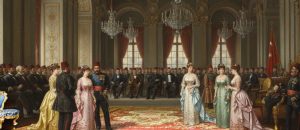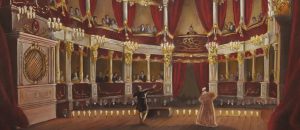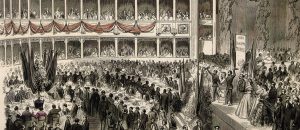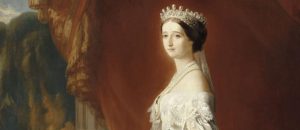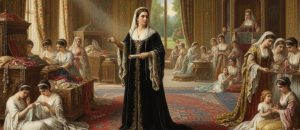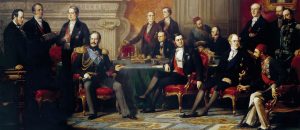The clothing revolution experienced during the Dolmabahçe Palace period is one of the most visible and symbolic reflections of Westernization. Traditional Ottoman garments that had persisted for centuries, such as the kavuk (turban), kaftan, and şalvar (baggy trousers), were replaced by the fes (fez), redingote (frock coat), and frak (tailcoat) for men, and by robes and gowns following Paris fashion for women. This fundamental change in clothing codes was not merely following a fashion trend; it was also a powerful political and cultural declaration announcing that the Sultan and the governing elite had adopted a modern mentality and were speaking the same visual language as the Western world. The corridors of Dolmabahçe had become the runway for this clothing revolution.
The Revolution Initiated by Sultan II. Mahmud: From Kavuk to Fez
The foundations of the clothing revolution in the Palace were laid before Dolmabahçe, during the reign of Sultan II. Mahmud. After abolishing the Janissary Corps, Sultan II. Mahmud mandated that the modern army he established wear Western-style trousers, jackets, and short jackets (setre). His most radical step was replacing the complex system of turbans (sarık) and kavuks, which had determined the status of Ottoman civil servants for centuries, with the fez—a single, uniform headwear for everyone. Although the fez did not resemble a Western hat, it was adopted as a practical “modern yet Muslim” solution because it did not prevent the head from touching the ground during prayer (namaz). This clothing reform was part of the desire to create a modern and standardized bureaucracy by equating state officials under a single “civil servant” identity.
Men’s Fashion at Dolmabahçe: Redingote, Tailcoat, and Western Elegance
During the Dolmabahçe Palace period, this change initiated by Sultan II. Mahmud was taken further. Sultans, princes (şehzadeler), and pashas began to wear attire completely consistent with European fashion in daily life and during official ceremonies.
Redingote and Setre: The redingote (frock coat) and setre (short jacket), which were dark-colored jackets extending to the knees worn during the day, became the standard attire for civil servants and palace officials. This represented a style that was entirely different from Topkapı’s silk, embroidered, and colorful kaftans—a style that was simpler, serious, and “functional”.
Frak (Tailcoat): For official receptions, balls, and the welcoming of foreign ambassadors held in the evenings, the mandatory attire was the tailcoat (frak). With its tailed black jacket, white vest, and bow tie, the tailcoat was the most formal garment of the European aristocracy. The Ottoman Sultan wearing a tailcoat was a visual manifesto declaring that he considered himself equal to an emperor in Vienna or London.
Robe de Chambre: Even the robdöşambr (robe de chambre), a dressing-gown-like garment worn by the Sultan during more private moments inside the palace, reflected a Western concept of comfort replacing traditional indoor kaftans.
Women’s Fashion in the Harem: Winds of Paris
While the change in men’s fashion was experienced more radically by the Sultan’s decree, the change in the Harem was slower but equally defining. The outward-facing windows of the Dolmabahçe Harem also allowed the winds of Parisian fashion to enter.
From Entari and Şalvar to Robes: Traditional, loose-fitting şalvar (baggy trousers) and entari (long tunic/dress) began to be replaced by corseted, voluminous-skirted, Western-style “robes” and gowns. The palace women followed fashion journals coming from Paris (the precursors of Vogue) and ordered the newest fabrics (satin, taffeta, tulle) and models.
The Evolution of the Veil (Peçe) and Outer Robe (Ferace): Although the ferace (outer garment) and yaşmak (thin veil covering the face) worn on the street maintained their existence, over time, they began to be made from thinner fabrics, adorned with richer decorations, and took on forms that revealed the face more. This was a sign that the understanding of privacy/modesty (mahremiyet) was also slowly changing.
Accessories: Gloves, fans, parasols, and diamond brooches imported from Europe became indispensable accessories completing the Harem women’s attire.
A Mirror of a Mental Revolution
This clothing revolution in Dolmabahçe Palace was not merely a change in aesthetic preference. It was the most sincere admission of a fundamental mental revolution. Traditional Ottoman garments were based on a system that instantly revealed a person’s social status, profession, and religious affiliation. Modern Western clothing, however, eliminated these distinctions, bringing the person forward more as an “individual” and making them part of an international norm. A Sultan wearing a tailcoat or a princess wearing a Paris-style gown was saying, “I am part of this modern world”.
Conclusion
In conclusion, the entry of new garments like the fez, tailcoat (frak), and robe de chambre into the Dolmabahçe Palace wardrobe is one of the most colorful and personal scenes of the Ottoman Westernization journey. These modern clothes, replacing Topkapı’s magnificent yet inward-looking kaftans, reflect an empire’s desire to reshape not just its buildings but also its body and identity. This clothing revolution was a harbinger of a major social and cultural transformation that started within the palace walls and would eventually affect the entire society.








